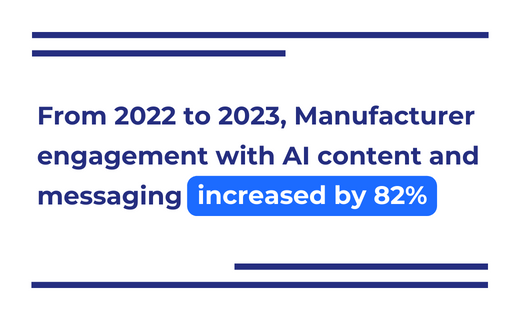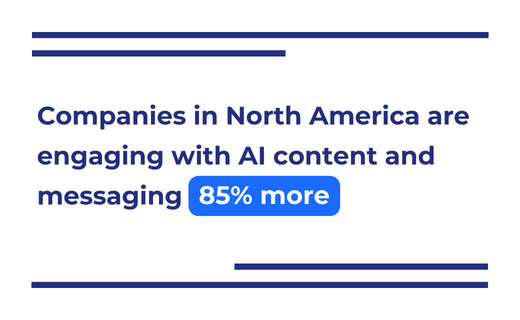
We’ve Seen a 117% Increase in Small and Medium-Sized Businesses Researching AI Solutions. Here’s Why Marketers Need to Capture Their Attention

The rise of accessible artificial intelligence (AI) solutions has revolutionized how we work. Previously seen as a technology confined to science fiction stories, statistics reveal that an increasing number of companies are now incorporating AI into their business operations. In 2022, 35% of businesses worldwide reported using AI technology in some capacity—an increase of four percentage points from 2021.
As businesses continuously seek methods to outperform their competitors, it is evident that AI has become the new frontier for enhancing productivity, driving economic growth, and achieving competitive differentiation.
Although the widespread use of AI is predominantly observed among leading enterprise companies, there has been a significant surge in research on AI solutions by small and medium-sized businesses (SMBs). This surge indicates a probable increase in purchases and implementations later this year. As AI-powered solutions such as intelligent process automation, predictive analytics, chatbots, and virtual assistants continue to streamline operations, improve customer service, and provide insights for informed decision-making, it is expected that interest among SMBs will only intensify.
This heightened interest among SMBs presents marketers with a unique opportunity to capitalize on this emerging market. With an astonishing 117% increase in SMBs researching AI solutions over the past year, marketers should seize this interest and target this audience with personalized content and messaging that directly addresses their concerns and pain points.
So, how can marketers leverage a data-driven account-based marketing (ABM) strategy to identify buyers, engage them with relevant content, and optimize campaigns for maximum impact on pipeline and revenue? Let’s find out.
Identify and Prioritize In-Market Accounts and Buying Committee Members
SMBs are increasingly researching how AI can impact their businesses, despite historically being considered a game for large organizations. However AI-related content targeting for SMBs has been relatively low, making them a prime category of buyers providers should target.
According to Gartner, SMBs are defined as organizations with 100 to 999 employees. Another criterion commonly used to determine the SMB market is annual revenue: small businesses typically have less than $50 million in annual revenue, while midsize enterprises have annual revenue ranging from over $50 million to less than $1 billion.
 Within the SMB market, our data reveals that the Manufacturing vertical shows high engagement and research activity with AI content and messaging. AI implementation in manufacturing brings several benefits, including increased efficiency, improved quality control, and enhanced predictive maintenance.
Within the SMB market, our data reveals that the Manufacturing vertical shows high engagement and research activity with AI content and messaging. AI implementation in manufacturing brings several benefits, including increased efficiency, improved quality control, and enhanced predictive maintenance.
Geographically, our data indicates that companies in the Europe, Middle East, and Africa (EMEA) region are highly engaged with and targeted by AI-related content and messaging. On the other hand, the North American region displays significant research and engagement with AI content but receives relatively low targeting from AI providers. This makes the North American region a promising target for AI solutions. North American businesses have demonstrated a strong appetite for exploring and adopting AI across diverse sectors, including finance, healthcare, manufacturing, and retail. Moreover, buyer research conducted in North America highlights the region’s commitment to remaining at the forefront of technological advancements.
 Another intriguing trend revealed by our data is the active role played by different members of the buying committee in the purchase decision process. While the Operations department continues to be responsible for the research process in AI purchases, we have observed an 8% decline in the involvement of individuals in Security roles. Furthermore, despite AI content being primarily targeted towards C-Suite executives and Vice Presidents, it is Directors who exhibit the highest engagement and increasingly engage in background research for AI solutions.
Another intriguing trend revealed by our data is the active role played by different members of the buying committee in the purchase decision process. While the Operations department continues to be responsible for the research process in AI purchases, we have observed an 8% decline in the involvement of individuals in Security roles. Furthermore, despite AI content being primarily targeted towards C-Suite executives and Vice Presidents, it is Directors who exhibit the highest engagement and increasingly engage in background research for AI solutions.
Execute a Personalize Campaign Strategy at Every Stage of the Sales Cycle
To increase conversion rates, marketers should create persona-relevant and easily consumable content focused on AI. This content should be mapped to each stage of the buyer’s journey to take ownership of the customer experience.
According to our ML Insights data, there has been a remarkable 154% year-over-year increase in engagement with AI-related content among individuals in Compliance roles. As AI continues to be a consistently popular topic, businesses are rapidly prioritizing its integration into their workflow. This surge in engagement suggests that those in Compliance roles are keen on understanding how AI can enhance the efficiency and accuracy of regulatory compliance processes. AI algorithms can rapidly analyze vast amounts of data, identify patterns, and detect potential compliance breaches. This assists compliance professionals in streamlining their work and mitigating risks. Additionally, AI solutions offer real-time monitoring and alerts, ensuring timely adherence to changing regulations and reducing errors related to compliance. Marketers targeting this group with AI solutions would be wise to emphasize these benefits in their content and messaging.
Marketers can leverage the growing interest in AI by incorporating machine learning, big data analytics, deep learning, and predictive analytics content into their promotional strategy. The content and messaging should also demonstrate how businesses can seamlessly integrate AI into their workflow, highlighting specific use cases such as application migration and hybrid cloud implementation.
Continuously Measure and Optimize Campaign Strategy for Maximum Impact
To maximize conversions and accelerate deal velocity, marketers should actively create and implement optimizations across companies, content, and personas. By continuously measuring success based on real-time pipeline impact, marketers can quickly identify optimization opportunities through multi-channel engagement.
Successfully targeting AI buyers requires marketers to address their specific needs and guide them through the buying journey with relevant content. By analyzing metrics such as pipeline volume, value, and velocity, marketers can gain insights into how an account progresses through the buying journey.
If an account is not advancing through the pipeline, marketers should review their targeting strategy based on data analysis. For instance, our ML Insights data indicates that larger-sized enterprises are being overwhelmed with AI messaging, while SMBs, particularly micro-sized organizations, are not being targeted enough despite displaying significant buyer research activity.
By shifting targeting efforts towards these micro-organizations and delivering content that emphasizes predictive analytics and application migration use cases, accounts will progress more swiftly through the buying journey due to receiving the content they require. The ML Platform assists marketers in identifying content and targeting gaps, enabling them to optimize campaigns effectively. This level of detail provides a more accurate understanding of the buyer’s journey, engagement, and pipeline impact, empowering marketers to uncover optimization opportunities and increase the efficiency of their media investment.
Every Successful B2B Marketing Strategy Begins with Data
Marketers need data to identify key accounts and personas, develop personalized campaigns, and measure and optimize campaign performance.
At Madison Logic, we use the world’s leading purchase intent data signals to help marketers accelerate the buyer’s journey and drive pipeline.
ML Insights offers B2B marketers the most advanced dataset available, simplifying the identification of in-market accounts, the prioritization of individuals to engage within the organizations, and the content that can accelerate the sales cycle for each audience. We achieve this through the MLI Score, a holistic signal that unifies three key data sources to reveal who’s being targeted, who’s engaging with content, and who is researching solutions so you can go after the accounts with the highest propensity to purchase. And when combined with CRM and MAP first-party customer data, marketers using ML Insights gain deeper insights to maximize their marketing spend and accelerate accounts through the buying journey.
Want more information about how to embrace data to develop more target and personalized campaigns that drive higher engagement and accelerate conversion across the sales cycle? Click on the links below to learn more:
- Why Quality Data is the Key Ingredient for Creating More Successful ABM Campaigns
- Madison Logic Named a Leader for Intent Data in New Analyst Report
- Three Ways Intent Data Helps You Maximize the Effectiveness of Your Marketing Spend

